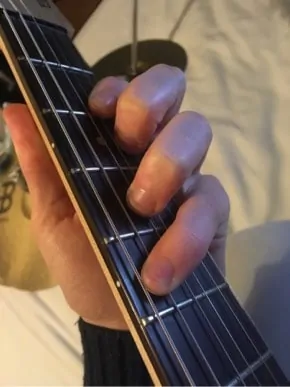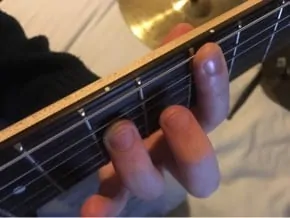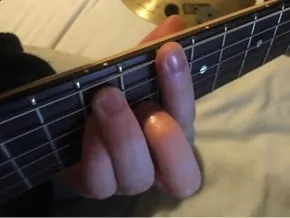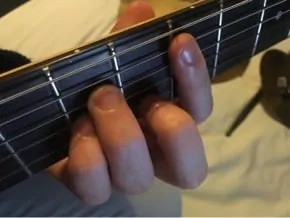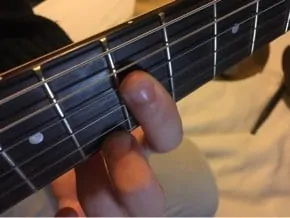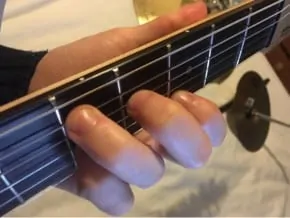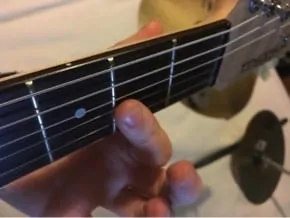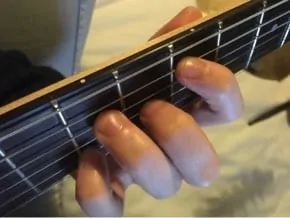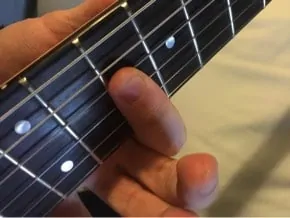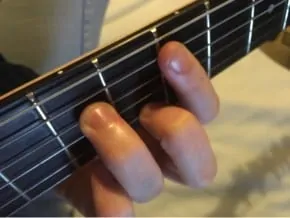There are a lot of chords you’ll come across while learning guitar, but few of them will crop as much as a simple D chord. We’ve done a lot of guides to how to approach playing chords through various techniques, and many different variations on these basic shapes.
In this important guide, I’ll be taking you through a huge number of variants of the D chord:
If you’re looking for a place to start with D chords, then look no further…
Contents
D Major Chord
Every major scale has the same theory behind it, building on a pattern of tones between the notes: 1-1-1/2-1-1-1-1/2. On a piano, the ‘1’ means that if you’re starting on the C, then there will be one note (Db in this case) between your C and the next note of the scale (D), while the 1/2 means that the next note of the scale is directly next door (such as in the move from E-F in C major). On a guitar, the 1/2 means the next fret is in the scale, and the 1 means there will be a fret in between the two notes.
D major: D-E-F#-G-A-B-C#
Each of these notes (degrees of the scale) can be assigned a number as it ascends so you can use a helpful formula to work out chords from it. The D is a 1, the E is a 2 etc.
Once you’re familiar with the scale, you’ll do well to remember that the formula for a D major chord (and any tonic major chord of any key) is 1-3-5 which gives the notes D-F#-A.
Within the key of D major, you can make various chord sequences and work them out using this numbering system, but remember that D major is your tonic, and is where the key will sound resolved and at home.
Songs That Use D Major Chords
Much like with A (or any other chord) bands will very rarely choose a chord based on its root note, and instead will make their choice based on the type of chord. Major chords give out a positive sound (though in a minor key context they can still hold sadness), so this gives them a versatile range, though you’ll rarely hear an open D major chord in really heavy music unless they’re looking for a blurry sound!
- Nirvana- All Apologies
- Pulp- Common People
- Sheryl Crow- First Cut Is The Deepest
- The Pretenders- Sense Of Purpose
- The Rolling Stones- The Last Time
- Blink 182- All The Small Things
- Bob Marley- Three Little Birds
Playing D Major
Variation 1
This first version of D major is a nice easy one, with a shape you’ve probably come across before. It’s easy to get into, and there are a lot of ways you can add to it (such as bringing your little finger onto the 3rd fret of the 1st string to add a suspended 4th). This variation would work really well when playing acoustic guitar.
You’ll want to put your 3rd finger on the 2nd fret of the 1st string, your 4th finger on the 3rd fret of the 2nd string and your 2nd finger on the 2nd fret of the 3rd string. Make sure you hit the open 4th string, but mute both the 5th (unless you want a 2nd inversion chord) and 6th.
Variation 2
This version is a little harder to pull off thanks to its big stretches, but it gives your D major chord a much fuller sound than the above. It can even be moved up and down the neck and transpose to different degrees of the scale.
Use your 2nd finger to barre the 2nd fret from string 3-1, then press your 3rd finger onto the 3rd fret of the 2nd string. Stretch your 4th finger over to the 4th fret of the 4th string, and your 5th finger over to the 5th fret of the 5th string. Make sure to mute the 6th string.
Variation 3
This type of D major chord isn’t used all that often, but thanks to its nice bridge-like barre, it can be used really well in staccato, jazzy playing- so bear that in mind!
You’ll want to start by using your 2nd finger to press down on the 5th fret of the 5th string, then simply barre the 7th fret using your 4th finger from string 4 to string 2.
Variation 4
Finally, we have the moveable major shape, this time obviously being used to play D major. This one is good for a lot of reasons, as it avoids the jangling of open strings if playing on electric guitar, but also allows you to mute and staccato it really easily.
You’ll want to barre the 10th fret using your 2nd finger, then use your 3rd finger to press the 11th fret of the 3rd string, your 5th finger to press the 12 th fret of the 4th string and your 4th finger to press the 12th fret of the 5th string.
D Minor Chord
A minor scale differs slightly from a major scale in that degrees 3, 6 and 7 are all flattened, so they are lowered by one semitone. This creates the D natural minor scale (variants such as the harmonic and melodic minor will be looked at in a separate guide).
D minor: D-E-F-G-A-Bb-C
We could apply numbers to these much like we did with the major scale, so an A minor chord would still be 1-3-5, like the major. But this is a bit confusing, so let’s approach it from the context of the major scale.
A D minor chord is 1-b3-5, so therefore made up of the notes D-F-A.
Songs That Use D Minor
Again, rarely does a song seek to use the D note, but will look to use a type of chord in order to create a certain sound. A minor chord is a lot darker and sadder than a major chord, so a lot of the time, its context will be in music of this type, but it’s always contextual.
- Lady Gaga- Telephone
- Oasis- Songbird
- Tears For Fears- Shout
- Black Sabbath- Solitude
- The Beatles- Don’t Let Me Down
- The Doors- Break On Through
Playing D Minor
Variation 1
We can start with a nice easy one. This is basically the same as our D major open chord (very good, and common, in acoustic music) but replaces the F# major 3rd, with a F- the minor 3rd.
Use your 2nd finger to press the 1st fret of the 1st string, your 4th finger to press the 3rd fret of the 2nd string and your 3rd finger to press the 2nd fret of the 3rd string. Again, hit the open 4th string and mute the 5th and 6th.
Variation 2
This variation is similar to the above, but rather than open strings, we bring a few of the notes up. This creates a moveable shape that will give you a much dreamier sound.
Your 3rd finger should press down on the 3rd fret of the 4th string, your 2nd finger on the 2nd fret of string 3, your 4th finger on the 3rd fret of the 2nd string and your 5th finger should stretch down to the 5th fret of the 1st string.
Variation 3
This D minor chord is the typical moveable shape we’ve been seeing a lot in this guitar chord guides, as it is a really helpful way to make the sound you’re going for on whichever note you need to make it.
Barre the 5th fret from the 5th-1st strings (mute the 6th), then press your 4th finger onto the 7th fret of the 4th string, your 5th finger onto the 7th fret of the 3rd string and your 3rd finger onto the 6th fret of the 2nd string.
D7 Chord
An D7 chord, or D dominant 7, is a major chord with an added minor 7th. This creates an interval of a tritone within the chord, adding a laying of dissonance to the sound. In a lot of music, the D7 is used as part of a perfect cadence, in order to resolve to the tonic. However, one of the primary uses of the dominant 7th in modern music, is as a part of jazzy chord sequences.
If we use major scale theory (which we would unless you’re delving into the realm of modality where this chord has a strong Mixolydian quality) then the formula for this chord is 1-3-5-b7. The b7 takes the C# of a D major scale down to a regular C.
This means that the notes in a D7 chord are D-F#-A-C.
Songs That Use D7
While a D7 can be used in any context, this type of chord can be found in a huge amount of jazz due to its massively ‘jazzy’ nature. Contextually, this chord can give an air of unease due to the dissonant intervals within it, but at the same time can sound uplifting due its major 3rd.
- Michael Jackson- Bad
- Don McLean- Vincent
- James Brown- Think
- The Beatles- Yesterday
- Cat Stevens- Wild World
- Post Malone- Better Now
- The Dubliners- The Wild Rover
Playing D7
Variation 1
Luckily for us, we have another nice and easy open chord that can produce a D7, and again it only really takes one note to change from the regular major chord. This version of the chord will only really be used when the chord is being allowed to sustain, due to its open string.
Keep the 4th string open, but mute (or avoid playing) strings 5 and 6. Place your 3rd finger on the 2nd fret of the 3rd string, your 2nd finger on the 1st fret of the 2nd string and your 4th finger on the 2nd fret of the 1st string.
Variation 2
Another of our easy, moveable shapes and definitely my favourite way to play D7 is this barred version. It allows you to approach the chord from a variety of ways, and can be easily slotted in to any genre with ease.
Barre your 5th fret from string 5-1 (mute string 6 again), the press your 4th finger onto the 7th fret of the 4th string and your 5th finger onto the 7th fret of the 2nd string. Make sure your barre is strong enough to bring out the 5th fret of the 3rd string, as this is where the 7th is.
Variation 3
Another jazzy approach is this bridge-type chord. It lends itself really well to staccato jazzy playing, but thanks to having quite high notes, it gives off quite a nice mandolin-like sound that is often desirable.
Use your 2nd finger to barre across fret 7 of strings 4, down to 1. Then add your 3rd finger onto the 8th fret of the 1st string. Easy!
Variation 4
This is a bit of a weird one, and I haven’t seen it in use that often, but if you’re looking for a lower alternative without hitting open strings, then this is your best bet.
Mute both the 1st and 6th strings, as they’d produce highly clashing E’s against your D7. Then use your 2nd finger to press the 3rd fret of the 2nd string, press your 3rd finger onto the 4th fret of the 4th string, your 4th finger onto the 5th fret of the 5th string and your 5th finger onto the 5th fret of the 3rd string.
D Major 7 Chord
A Dmaj7 chord is simply a major chord with a major 7th attached to the top. This often gives it a very uplifting sound, but there is an underlying dissonance due to the major 7th interval.
If we look at it from the point of view of the major scale algorithm, then the chord outlines a pattern of 1-3-5-7.
This means that the notes in an Dmaj7 chord are D-F#-A-C#.
Songs That Use Dmaj7
The dissonance within the chord means that it is used by a lot of jazz musicians, but the chord is no stranger to pop music as it has an immensely satisfying sound.
- Daniel Caesar- Best Part
- Pink Floyd- Time
- The Cure- In Between Days
- Brockhampton- Waste
- Frank Sinatra- My Way
- Amy Winehouse- Valerie
Playing Dmaj7
Variation 1
The open variation of Dmaj7 is possibly our easiest open D chord so far as all it takes is one single barre. Again, this is nice when used in acoustic music due to the ringing of the open string.
Use your 2nd finger to barre the 2nd fret of the 1st, 2nd and 3rd strings and then hit the open 4th string with it. Mute strings 5 and 6.
Variation 2
It gets to be a bit more of a stretch here, as many of your fingers will be given quite the workout, so make sure you’re comfortable with some big jumps before you attempt this version of the chord.
Use your 2nd finger in the same way as above- barring the 2nd fret of the 1st, 2nd and 3rd string. Then jump your 4th finger all the way over to the 4th fret of string 4, and your 5th finger over to the 5th fret of string 5.
Variation 3
Our nice, moveable Dmaj7 shape is one of the nicest sounding chords to have sliding up and down the neck. It’s quite simple to create, and lends itself well to both pop and jazz due to the versatility of the chord.
Put your 2nd finger on the 5th fret of the 5th string, then your 4th finger on the 7th fret of string 4, your 3rd finger on the 6th fret of the 3rd string and your 5th finger on the 7th fret of the 2nd string. Mute the 6th string, but you could extend your 2nd finger out into a barre if you want to include the 5th string of the 1st string.
Variation 4
The Dmaj7 has a huge variety of fun voicings, and they all sound great because it’s such a pretty chord. This one works well when you’re going from a harp-like, dreamy sound. Try slowly arpeggiating this variation and you’ll see what I mean.
Put your 2nd finger on the 9th fret of the 1st string, your 3rd finger on the 10th fret of the 2nd string, your 4th finger on the 11th fret of the 3rd string and your 5th finger on the 12th fret of the 4th string.
D Minor 7 Chord
The Dm7 chord (D minor 7) is based on a minor chord with a minor 7th above. It’s sort of the sadder version of the major 7th chord, giving off more of a negative sound due to the minor 3rd, but less dissonance due to the minor 7th interval instead of the major 7th.
If we look at it using the major scale formula, then it follows a pattern of 1-b3-5-b7.
This means that the notes in a Dm7 chord are D-F-A-C.
Songs That Use Dm7
Dm7 is similar in its use to Dmaj7, as it can give flair and dissonance to a piece, and so lends itself nicely to pop music. Its dissonance, though, allows it to be heard in a lot of jazz music.
- Red Hot Chilli Peppers- Scar Tissue
- Bob Dylan- Like A Rolling Stone
- Coldplay- The Scientist
- The Eagles- Best Of My Love
- Maroon 5- Sunday Morning
- Kansas- Dust In The Wind
- Mac DeMarco- Another One
- Eric Clapton- Forever Man
- B.o.B- Nothing On You
- Stevie Wonder- I Wish
Playing Dm7
Variation 1
The open version of the Dm7 continues the theme of open D chords being very simple to play. Again, as I’ve said above, the ringing open strings of this chord allow it to sound great on acoustic guitar.
Keep your 4th string open as that is the D tonic, then press your 3rd finger onto the 2nd fret of the 3rd string, and make a small barre across the 1st fret of the 1st and 2nd strings, using your 2nd finger.
Variation 2
This bridge shape chord is a good one for use in jazz again, as it can be played staccato, with the added bonus of being able to slide up and down frets in a jazzy way.
You can either, very simply, barre the 10th fret of strings 1-4, or make a bridge shape using your 2nd, 3rd, 4th and 5th fingers on the 10th fret of the 4th, 3rd, 2nd and 1st strings respectively.
Variation 3
One of my favourite moveable barre shapes is the minor 7th, which can be moved up and down the frets with ease.
Press your 2nd finger down across the 5th fret, muting the 6th string to avoid an unpleasant clash. Then press your 4th finger onto the 7th fret of the 4th string, then your 3rd finger on the 6th fret of the 2nd string. Make sure to emphasise the 5th fret of the 3rd string, as this is the m7 interval.
Variation 4
This moveable shape is less common than the above, but can still create a great sound. Its barre means it is easy to mute, and the low strings mean overdrive can still sound good on this chord.
Barre the 10th fret with your 2nd finger, and then use your 4th finger to press down on the 12th fret of the 5th string.
Other D Chords
There are a lot of other types of chords you can use based around a D tonic. The ones I’ve shown you so far are probably the most common you’ll come across, particularly major and minor.
- Ddim7 is another nice easy open chord that only takes two fingers. Due to the two diminished intervals within the chord, it gives a really unstable feeling that needs to be resolved to another chord. This makes it an important chord despite it being so easy.
- Dmaj6/9 has an interesting, bridge-like shape that can be transposed up and down the neck easily. It is used a lot in soul music, but makes for a nice substitution for a regular major chord.
- Dm-maj7 combines a minor 3rd and a major 7th, which produces a strong clash. They’re quite rare, but can move to a regular m7 chord. It has a strong open variety, as well as a number of moveable variants.
There are obviously a lot more chords than this, but these are a few I really like. I have a few tricks to bear in mind when working out chords yourself.
- If you’re in an alternate tuning, remember these explanations won’t be the same!
- Using a formula to work out what notes are in a chord is a really simple way to help you out.
- When building chords that are hard to voice, the 5th is the first degree of the chord you are able to drop. Never drop the root, because that will normally completely change the chord you’re playing. For example, dropping the D from an Dm7 chord just makes F major…
Good Luck!

Dan is a music tutor and writer. He has played piano since he was 4, and guitar and drum kit since he was 11.
He plays a Guild acoustic and a Pacifica electric. He has been sent to many festivals and gigs (ranging from pop to extreme metal) as both a photographer and reviewer, with his proudest achievement so far being an interview he has with Steve Hackett (ex-Genesis guitarist).
He ranks among his favourite ever guitarists, alongside Guthrie Govan, Jimmy Page, Jimi Hendrix, David Gilmour and Robert Fripp. His favourite genre of music is progressive rock, which he likes to use as a reference point in my teaching, thanks to its huge complexity in structure, rhythm and harmony. However, he is also into a lot of other genres including jazz, 90’s hip-hop, death metal and 20th century classical music.

